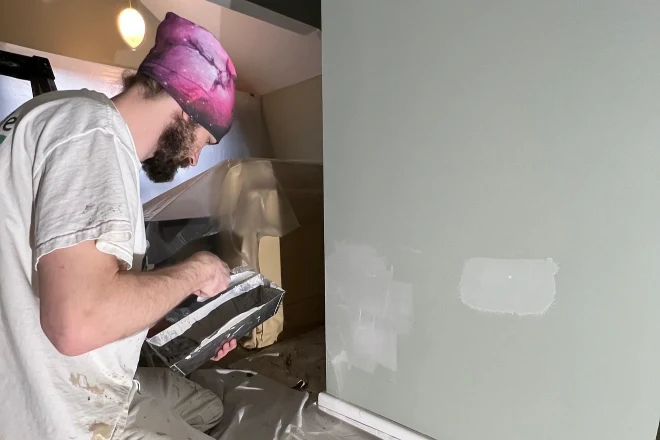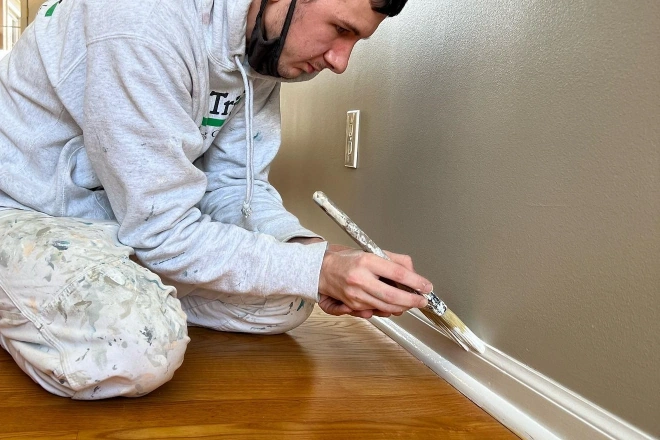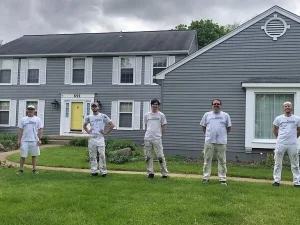Key Points
- Repair common wall paint issues like chips, peeling, streaks, stress cracks, and nail pops by identifying the root cause, prepping the surface, and using the correct repair technique for each problem.
- Use essential tools such as a putty knife, sanding block, primer, and joint compound to ensure smooth repairs that blend into existing wall finishes.
- Prevent recurring paint damage by controlling moisture, using quality paint and primer, and reinforcing drywall fasteners where needed.
Wall-to-Wall Solutions: A Fresh Look Starts with a Solid Fix
Noticing a flaky patch of paint or a mysterious crack on your living room wall?
Wondering how those small imperfections suddenly make your whole room feel unfinished?
You’re not alone—and you’re definitely not stuck with it.
In this step-by-step guide, you’ll learn how to fix the five most common wall paint problems found in Ann Arbor homes: paint chips, peeling, streaks, stress cracks, and drywall nail pops.
We’ll also show you how to avoid mistakes, choose the right tools, and keep your walls looking professionally finished.
By the time you finish reading, you’ll know exactly how to tackle those eyesores with confidence—and save yourself from bigger issues down the road.
Need a hand with the interior painting work?
Reach out to the pros at Tribble Painting Company anytime.
Give us a call or fill out our contact form to get started.
Why Wall Paint Fails: Understanding the Root Causes
Even high-quality paint can start showing flaws if the conditions beneath or around it aren’t right.
In many Ann Arbor homes, everyday wear, changing seasons, and moisture levels can cause wall paint to break down over time.
Here’s a look at what might be behind your wall paint problems:
Common Paint Issues and What Causes Them
- Paint Chips
- Scuffs from furniture, pets, or kids
- Moisture trapped under the surface
- Skipping primer or applying paint on a dirty wall
- Peeling Paint
- High humidity or steam, especially in kitchens and bathrooms
- Painting over glossy or greasy surfaces without sanding or priming
- Using the wrong type of paint or skipping primer
- Paint Streaks
- Using cheap brushes or rollers
- Uneven roller pressure or not blending strokes properly
- Applying too much or too little paint
- Stress Cracks in Drywall
- Normal settling of the house over time
- Seasonal temperature and humidity swings causing wood framing to expand and contract
- Leaks or water damage near ceilings, windows, or pipes
- Foundation movement in older or shifting homes
- Nail Pops
- Nails or screws in drywall shifting due to home settling
- Improperly secured drywall panels
- Humidity changes, loosening fasteners over time
Understanding what caused the damage is the first step to making lasting repairs.
In the next section, we’ll cover exactly what tools and materials you’ll need to tackle any of these issues like a pro.
Tools and Materials You’ll Need for All Repairs
Before you fix any paint damage, make sure you have the right gear on hand.
Having the proper tools and materials ready will help you work more efficiently and get better results—especially if you’re tackling multiple spots in your Ann Arbor home.
Tools
These are the basic tools you’ll need for most wall paint repairs:
- Drop cloths – Protect floors and furniture from drips and dust
- Painter’s tape – Keeps edges clean and sharp
- 5-in-1 painter’s tool – Great for scraping, spreading, and cleaning
- Putty knife – For applying spackle or joint compound smoothly
- Drywall taping knives – Ideal for covering cracks and seams
- Sanding sponge or block – Helps level and smooth patched areas
- Step ladder – Useful for reaching higher spots
- Paintbrushes – Use angled brushes for corners and flat ones for broad surfaces
- Paint roller and tray – For streak-free coverage on large areas
- Stud finder – Handy when reinforcing drywall around nail pops
Materials
Gather these supplies before you start:
- Sandpaper – Use medium grit for rough patches and fine grit for final smoothing
- Joint compound – Fills in cracks and covers joint tape
- Spackle or lightweight filler – Perfect for small dents and chips
- Drywall joint tape or mesh – Reinforces repairs on stress cracks
- Interior primer – Seals repairs and preps surfaces for paint
- Matching interior wall paint – Choose the right finish and color for a seamless look
- Drywall screws – Secure loose drywall where nails have popped
Having everything ready upfront saves time and prevents mid-project runs to the store.
Fixing Paint Chips on Walls

Chipped paint can instantly make your walls look worn down, even if the rest of the room looks great.
Whether the damage is from furniture bumps, moisture, or poor prep work, fixing chipped paint is a simple DIY task that can help your Ann Arbor home look freshly painted again—without repainting the entire wall.
What Causes Chipped Paint?
- Furniture contact – Moving chairs, tables, or vacuum cleaners too close to the wall
- Improper surface prep – Painting over dust, oils, or glossy finishes without sanding or priming
- Moisture – Water seeping through drywall or behind trim can weaken adhesion and lead to chips
Step-by-Step: How to Fix Chipped Paint
Follow the steps for fixing paint chips on walls to get rid of those annoying flaws and blend the repair with the surrounding wall:
- Clean the damaged area
- Use a damp cloth to remove dust or debris from the chipped spot
- Allow the wall to fully dry before moving on
- Scrape and sand the chipped edges
- Use a putty knife to gently remove any loose paint around the chip
- Lightly sand the edges so the surface is smooth and flat
- Fill with spackle
- Apply a thin layer of lightweight spackle or joint compound over the damaged area
- For larger holes, use joint compound instead of spackle
- Feather the edges so it blends into the wall
- Let it dry, then sand again
- Once the filler is dry, lightly sand the area until it’s flush with the surrounding wall
- Wipe away dust with a dry cloth
- Prime the patched area
- This step helps the new paint stick and prevents flashing (a dull spot that shows through)
- Repaint and blend
- Use a small brush to repaint the spot with a color match to your existing paint
- Feather the edges so the repair disappears into the rest of the wall
Pro Tips
- Always check lighting—natural light shows flaws best
- Use leftover paint from your last project if you still have it
- Don’t overload your brush—multiple thin coats blend better than one thick one
Taking a few extra minutes to smooth, prep, and color match can make the difference between a noticeable patch and a flawless fix.
Fixing Peeling Paint
Peeling paint isn’t just an eyesore—it’s a warning sign.
Whether it’s showing up around bathroom ceilings, kitchen walls, or anywhere moisture sneaks in, peeling paint means something wasn’t right underneath.
Luckily, you can fix peeling paint and stop it from coming back with the right prep and products.
Why Paint Peels
Peeling happens when the bond between the paint and the surface breaks down.
Here are some of the most common causes in Ann Arbor homes:
- High humidity – Bathrooms, laundry rooms, and kitchens are peeling hotspots due to excess moisture
- Skipping surface prep – Painting over dirt, oil, or gloss without sanding or priming
- Wrong products – Using low-quality paint or combining incompatible formulas (like latex over oil without primer)
- Water damage – Leaks behind walls or around windows can cause paint to lift and peel
- Lack of primer – Paint needs a solid base to stick; without it, peeling often appears fast
Step-by-Step: How to Fix Peeling Paint
- Scrape away peeling sections
- Use a 5-in-1 tool or putty knife to remove all loose, flaking paint
- Don’t stop at the obvious areas—check nearby sections for paint that may be ready to pull away
- Clean the wall
- Wipe down the area with a damp cloth to remove dust, grease, or leftover debris
- Repair the surface
- Use spackle or joint compound to fill any gouges or uneven spots
- If you need to build up areas, apply thin coats and let each dry before adding the next
- Sand the repair smooth to match the wall’s texture
- Prime before painting
- Use a high-quality bonding or stain-blocking primer—especially in high-moisture areas
- This helps prevent future peeling and gives your paint a stable base
- Repaint the area
- Use a quality interior paint that’s suited for the room’s conditions (moisture-resistant for bathrooms, for example)
- Feather edges so the touch-up blends into the rest of the wall
- For bigger repairs, you may need to roll over the entire section for a more even finish
Moisture Management Tips
- Run exhaust fans during showers or when cooking
- Fix leaky pipes, windows, or roofs before repainting
- Avoid painting on humid days—let the room fully dry out if needed
Taking the time to fix peeling paint the right way means longer-lasting results and less frustration.
And if the problem keeps coming back, it might be time to call a professional to investigate what’s going on beneath the surface.
Follow the links to learn how to fix peeling paint on the outside of your house and how to fix peeling paint on your ceiling.
Fixing Paint Streaks

Few things are more frustrating than stepping back from a freshly painted wall and spotting streaks—especially when the light hits just right.
Streaky paint can ruin the look of a room, no matter how good the color choice is.
But by following our instructions, you can learn how to fix paint streaks on walls and prevent them from showing up again.
Common Causes of Paint Streaks
- Uneven roller pressure – Pressing too hard or not applying even pressure when rolling
- Poor-quality tools – Cheap brushes or old rollers can leave lines and marks
- Overlapping errors – Not blending strokes while the paint is still wet
- Wrong technique – Skipping the “W” or “M” pattern and painting straight up and down too quickly
- Low-quality or mismatched sheen – Using the wrong finish or mixing finishes can make streaks more visible
Step-by-Step: How to Fix Paint Streaks
- Sand down the streaks
- Lightly sand the affected area using fine-grit sandpaper to remove ridges and level the surface
- Clean the surface
- Wipe off any dust from sanding to ensure the new paint sticks well
- Repaint using the right technique
- Use a high-quality roller and make sure it’s loaded evenly
- Apply paint in a “W” or zigzag pattern, then fill it in without lifting the roller
- Keep a wet edge and blend as you go—especially in high-visibility areas and near corners
- Check your tools and paint
- Make sure your roller matches the texture of your wall (smooth, semi-smooth, etc.)
- Use consistent pressure and apply the same number of coats throughout
- Always use the same sheen and batch if touching up later—differences in finish can create visible patches
Tips for a Smooth Finish
- Paint in natural daylight to catch flaws early
- Stir paint thoroughly before each use for consistent coverage
- If needed, repaint the entire wall section to create an even look
Correcting streaks takes a bit of patience, but the end result is worth it.
Fixing Stress Cracks in Drywall
Stress cracks are common in homes across Ann Arbor, especially in older houses or those experiencing seasonal shifts.
These small splits in your drywall may look minor, but they can pull attention away from an otherwise clean finish.
Knowing how to fix stress cracks in drywall the right way helps restore the surface and prevent them from coming back anytime soon.
What Causes Stress Cracks?
- House settling – Natural movement over time can create tension in drywall seams
- Seasonal expansion and contraction – Michigan’s changing temps and humidity levels cause framing to expand and shrink
- Water damage – Leaks behind walls can weaken drywall and lead to cracking
- Lack of climate control – Inconsistent use of heating or AC lets indoor conditions shift too much
- Foundation issues – Cracks wider than ¼ inch may signal structural concerns and should be inspected by a pro
Step-by-Step: How to Fix Stress Cracks
- Protect the area
- Lay down a drop cloth to catch dust and splash from tools
- Open the crack slightly
- Use a 5-in-1 tool to gently widen the crack—this helps the filler grip and hold better
- Apply joint tape
- Press mesh or paper drywall tape firmly over the crack
- Add joint compound (also known as mud)
- Spread a thin coat of mud over the tape using a drywall knife
- Let it dry completely, then apply two more coats—each slightly wider than the last
- Sand smooth and level
- Once dry, sand lightly until the area is flush with the wall
- Make sure it blends into the surrounding surface
- Prime the patch
- Use a primer to seal the repaired section and prevent flashing when you paint
- Repaint and finish
- Repaint with the same color and sheen as the rest of the wall
- Feather edges for a seamless look, especially if the exact paint match isn’t available
Pro Tip
If cracks keep coming back in the same place, it’s worth checking for underlying structural issues—or bringing in a professional to inspect.
Otherwise, follow these steps, and your repair should last through Ann Arbor’s freeze-thaw cycles and beyond.
Fixing Nail Pops in Drywall
Nail pops are those small, round bumps or holes that suddenly show up on your walls or ceilings—often where drywall fasteners have started to pull loose.
They’re common in homes around Ann Arbor, especially in places where the house has settled or where temperature swings are frequent.
Thankfully, they’re simple to fix with a few steps and the right materials.
Why Nail Pops Happen
- Natural settling – Over time, your home’s framing can shift slightly, pushing nails outward
- Temperature or humidity changes – Expansion and contraction of wood can loosen drywall nails
- Improper fastening – Nails placed too shallowly or without enough support may not hold long-term
Step-by-Step: How to Fix Nail Pops
- Locate the nail pop
- If it’s a nail: Use a hammer to gently tap the popped nail just below the surface of the drywall
- If it’s a screw: Gently scrape the excess drywall mud away, and retighten the screw down
- Reinforce the area
- Add two drywall screws—one above and one below the nail—to secure the panel firmly to the stud
- This prevents the pop from happening again in the same spot
- Cover the area with joint compound
- Apply a smooth layer of mud over all three fasteners using a putty knife
- Let it dry fully before continuing
- Sand and smooth the patch
- Lightly sand the dried compound until flush with the wall
- Remove any dust before moving on
- Prime the area
- This step seals the repair and helps the final coat of paint go on evenly
- Repaint with matching color and sheen
- Use the same paint sheen as the rest of the wall—ideally from the original can
- Feather edges so the patch blends in naturally
Best Practices
- Use drywall screws instead of nails whenever possible—they’re stronger and less likely to back out
- If nail pops repeat often, your home might be experiencing more movement than usual—keep an eye on it
They may be small, but knowing how to fix nail pops keeps your walls looking clean and smooth for years to come.
Say Goodbye to Wall Woes with Tribble Painting Company
Now you know how to fix everything from chipped paint to drywall cracks using easy, step-by-step methods.
With the right tools, techniques, and attention to detail, your walls can look smooth, clean, and freshly painted again—no matter what caused the damage.
If you’d rather skip the mess and get flawless results, Tribble Painting Company is here to help.
From prep to finish, our expert painters know exactly how to make your interior walls look their absolute best.

